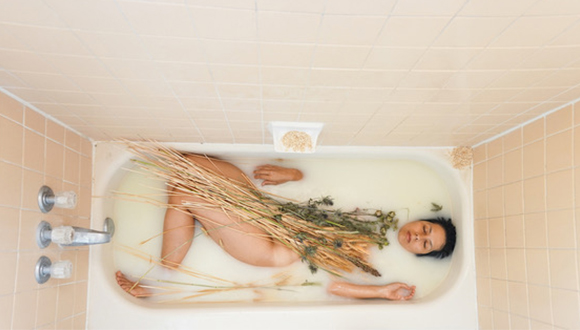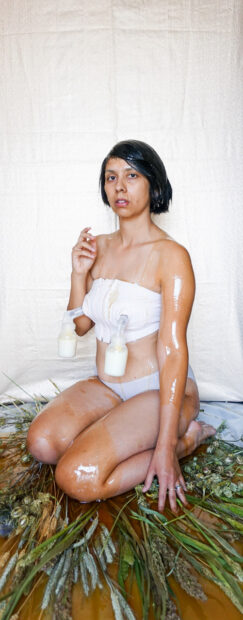
Jacqueline Saragoza McGilvray, “Milkbath,” 2022, inkjet pearl print, oats, wheat, thistle, breastmilk, 36×18 inches. Courtesy of the artist.
Unfiltered and transgressive, Jaqueline Saragoza McGilvray’s latest body of work, In a Time of Milk and Honey, stands as a testament to some of the challenges faced by working mothers in the United States. Started in 2019, the series explores McGilvray’s experience navigating the difficulties she encountered when she was breastfeeding her daughter. Her previous work has centered on ideas of sisterly affection, family history, wounds and healing, and the intricacy of one’s identity. Although drawing from her personal experiences, McGilvray’s work touches others with shared truths. She earned her MFA in photography and integrated media from Ohio University in 2013, and her BFA in photography from Texas State University in 2010. Her work has been exhibited nationally, and since 2014 McGilvray has served as curator and exhibitions manager for the Contemporary at Blue Star.
Ashley Allen (AA): Could you guide me through your process of creating this body of work?
Jacqueline Saragoza McGilvray (JSM): This body of work started with the breast milk material and trying to figure out what to do with it. As a working mother, I have had to rely on pumping my milk. Before returning to work after a very short six weeks of maternity leave, I was trying to build a stockpile of breast milk to compensate for being away from the baby and reductions that might happen, as there was an increasing the volume of milk that they need. My daughter started rejecting my milk and we were trying to figure out why. Finally, after speaking to multiple lactation consultants, one of them told me to taste the milk. If it has a high iron taste, which would make it taste kind of like blood, that means that there is an increase in the lipase enzymes which are breaking down the milk. Lipase is an important enzyme that helps babies digest breast milk. It is safe and nutritious for babies to drink. I had an increase in these lipase enzymes, which was affecting the taste of my breast milk and causing my daughter to reject it. One way to mask the taste is to heat the milk to a little over 100 degrees after pumping, which will stop the lipase enzyme from continuing.
This is just one of many challenges of being a working mother — you don’t have the time or space to pump properly, let alone have continuous access to a stove to heat your milk, or a freezer to store it. It’s equally defeating to read the solution and then realize that the solution is impossible. If I could achieve that solution, I would just be home. My milk began to fill everyone’s freezers, and I only had a two-day supply versus a two-month supply. That meant I could never be away from my daughter, or I would have to supplement with formula.
After choosing to breastfeed, I very quickly realized the things I didn’t know about it. So I read parenting books about early childhood and raising an infant, and breastfeeding is the most dominant part of that — It’s how you’re keeping your child alive, unless you use formula. I was reading a lot about the science of breastfeeding and about the nutrition of it. Then for myself, I also looked for sources of information about maternal experiences that were outside of Western medicine. Through this research, I quickly learned how the process has really been taken away from women and sterilized. I also learned that a lot of ancient practices surrounding giving birth and raising children have left medicine, even though they are just as scientific.

Jacqueline Saragoza McGilvray, “Surfacing and afloat,” 2022, inkjet pearl print, oats, wheat, thistle, breastmilk, 24×16 inches. Courtesy of the artist.
AA: From what I have seen of your previous work, it seems like you mostly stay outside of the camera’s physical view, although your work is largely personal, dealing with aspects of your family, home, and your lived experiences. This work is different — it uses your own breast milk and your image as subject. How has your process of thinking about your work and your chosen subject changed over time?
JSM: After thinking about this project for a while, it was very interesting that Milkbath was the first image I made. I haven’t shot self-portraits as exhibited work since undergrad. I took an intentional step away from doing that. I remember I shot some self-portraits during undergrad, and my professor Jason Reed encouraged me to show those images during critique. I think a lot of photographers create self-portraits, but they don’t necessarily show them.
Often, the things that you’re interested in when you’re a student are part of who you are and they keep coming up in your work in different ways. But after the experience of becoming a parent and trying to make work, another artist actually pointed out that it becomes a lot more directed. You no longer have wasted time in the studio, because when you get that window of time, you just attack, essentially. My husband commented “wow, you have managed to make a whole body of work in the tiniest window of time,” and that is a really good way of summarizing the experience of trying to continue your practice as a parent.
AA: You incorporate other organic materials such as plant matter and honey along with your breast milk in these photographs. What is significant about the use of these materials?
JSM: Yes, there are these plant elements throughout the body of work. There is wheat and thistle and also dried oats used to make oatmeal — these are some the foods that help increase the production of milk. This is considered colloquial knowledge, something that other women told me would help when breastfeeding, but it’s factual knowledge too. There is a lot of oral information shared between women that, if not recommended by your doctor, you don’t take seriously. This was also a big part of the process of becoming a mother.
With the honey dripping on my body in Santa Saragoza Patron Saint of Lactation and Labor, I was thinking about the hard work and continuous labor that is involved in the making of honey, and the metaphor of bees serving a queen. That is where that feminine idea continues to play a part. In the piece called Passive Immunity, there is a bottle filled with milk sitting on oranges and lemos — in this, one of the things I was thinking about is the shift from breastfeeding to solid foods. I also made this image during the height of COVID-19, so I was thinking about how breastfeeding passes antibodies to your child and helps them to build immunity to things. I started to think about how I am responsible for my child’s nutrition when I started transitioning to feeding my child solid foods. That’s where the citrus fruits come in for vitamin C, which helps build immunity and fight off viruses.

Jacqueline Saragoza McGilvray, “Santa Saragoza Patron Saint of Lactation and Maternal Labor,” 2022, inkjet pearl print, oats, wheat, thistle, breastmilk, honey, 36×14 inches. Courtesy of the artist.
AA: Could you elaborate on the performative aspects of this project and how you see your work within an art historical context?
JSM: Milkbath is an image of me in all of this milk that my daughter has rejected. Since there is a performative element to this type of photograph, the process is a little bit more important. In this image, I’m referencing Ophelia [John Everett Millais’ 1851-52 painting] through the posture of lying on my back and the expressionless, serene look on my face. I had to do test images of this one because I basically had one chance to dump each little frozen bag of milk in the tub and wait for them to defrost. Having my body submerged in the pool of milk with the lipase enzyme — the one that smells like iron — was not super fun. That’s why I did a bunch of test shoots and figured out how I wanted to rig the camera and everything. I decided it was just going to be done in one sitting.
My two core self-portraits are pointing to art historical references. Santa Saragoza Patron Saint of Lactation and Labor takes influence from religious paintings that originally would have been many panels in a similar long, vertical format. There is a lot of symbolism that I’m trying to integrate into the piece through the plants that are connected to lactation, the production of milk, and the title that incorporates my maternal last name. Also, rather than hold my baby in the piece, I included the bottles and attachments for pumping milk, which signify something specific about my experience.
I decided to cast myself as the patron saint of lactation when I read that the patron saint of lactation is a man. With this work, I was also thinking about depictions of Mary breastfeeding and the viewing of my own body and being able to experience it outside of objectification of the male gaze. Motherhood is a very powerful vehicle for that, and it made me think of how images of Mary breastfeeding are non sexualized. Religious images of a bare-breasted woman are permissible to view or to have in spaces of worship, or even to have integrated into a holy text.

Jacqueline Saragoza McGilvray, “Passive immunity,” 2022, inkjet pearl print, 11×17 inches. Courtesy of the artist.
AA: How do you think the work challenges established social boundaries and norms?
JSM: In the title, In a Time of Milk and Honey, I’m thinking about pushing against the societal and systemic challenges of the experiences that exist less in other cultures, because women have more support. It’s also the idea that milk and honey nourishes, and is sweet and precious, while it is also challenging. If you notice, there is a pink, flesh, and golden color palette to the work, with the honey creating this golden quality. Breast milk is often referred to as liquid gold because of its amazing properties. I had a show that didn’t end up happening because of COVID-19, but the curator of the space talked about how the images are transgressive, and I hadn’t really thought of that at all.
But just by representing this experience — which a lot of artists are doing now — I am asserting that this is always relevant and timeless. There are always millions of people going through this, which makes it a critical subject. This is a political experience, too, because it is constantly pushed against and undermined, and it is something that you actually have to fight to experience.
At the same time that I’m experiencing having kids, I have also been in conversation about it with other people that I know or that I’m working with internationally. I talk to parents from Norway or from Japan or from Mexico, and hear that they have two years of maternity leave, or months before they have the baby and then a year after giving birth. Many of them also have access to childcare anywhere they work. It baffles me that I can’t even understand what it means to have anything even remotely close to this, which is a problem. I think that anybody who has experienced it knows it is a problem, and by talking about it in my work, I want others to see this urgency.
This interview has been edited for length and clarity.
In a Time of Milk and Honey is on-view in a solo exhibition at St. Edward’s University in Austin from November 10 through December 8, 2022.


